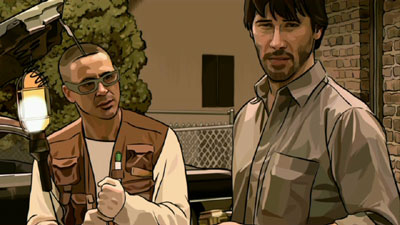Warner Independent Pictures (July 8, 2006), Warner Home Video (December 19, 2006), single disc, 100 mins plus supplements, 1.85:1 anamorphic widescreen, Dolby Digital 5.1, Rated R, Retail: $27.98
Storyboard:
In the near future, an undercover officer is asked to investigate himself and his drug-addicted friends; but as the investigation continues, is the officer going to lose his friends or his mind first?
The Sweatbox Review:
Any review of A Scanner Darkly must naturally begin with acknowledging that this film is based on a novel by Philip K. Dick, one of America’s most respected and adapted sci-fi authors. Having seen good Dick movies that were nonetheless weak adaptations (Blade Runner, Minority Report) and cheesy Dick movies that were also weak adaptations (Paycheck, Total Recall— though they had their moments), would audiences finally see a film based on a Dick film that was both faithful and good?

Depending on what critic you ask, the answer in regards to A Scanner Darkly may be either in the affirmative or the negative. Even those who liked the film still often reported that they didn’t really understand it, or that it required multiple viewings. On the other hand, there were those that simply did not like it, for various reasons that may have had to do with coherency, subject matter, or the visual style of the film. And of course there were those who have read Dick’s works and are better qualified than myself to judge the film on the basis of its merits as an adaptation. Nevertheless, from what I understand, this is probably the most faithful adaptation of Dick ever done.

Given that I have never taken the time to read any of Dick’s books (a situation which I do intend to remedy some day), I can only comment on the film. Let us start with the plot, which was not nearly so incomprehensible as some critics have suggested. Seven years from now in Anaheim, California, 20% of the population is addicted to a drug called Substance D. The government has given a single corporation called NewPath special rights in order to help end the epidemic and rehabilitate the addicts. Early in the film, NewPath holds a news conference to introduce one of its secret agents, who is wearing a “scramble suit” that protects his identity by continually shifting its appearance; the man is introduced as “Fred” (Keanu Reeves). Fred speaks to the gathered media, but loses his focus while talking before wrapping his speech up and walking off. If this is the best agent NewPath has, there could be trouble.
Things become somewhat weird when Fred, whose identity is a secret even to his superiors, is assigned to investigate a group of drug-abusing friends, and in particular one man named Bob Arctor. What is weird is that Fred and Bob are one and the same! The movie then follows the trail of Fred/Bob in both of his identities. At work, Fred discusses his case with his superiors, gets tested by medical agents looking for signs of stress or drug-induced duress, and monitors Bob and his friends. Bob, meanwhile, carries on with his friends in their shady, rundown home. Among his friends are Barris (Robert Downey, Jr.), an odd but verbose fellow who is always pontificating about something; Luckman (Woody Harrelson), a nut whose mental and social development seem to have both stalled out long ago; Freck (Rory Cochrane), an addict at the end of his rope, whose quirky mannerisms suggest the fragility of his psyche; and Donna (Winona Ryder), whose own descent into addiction keeps her a relatively remote romantic interest.

All along the way, drug-addled Fred/Bob seems to be losing touch with reality, while at the same time the plot of the film reveals that much of what we had assumed about this world is either wrong or has yet to be revealed. Fred/Bob may be mad, but the world is even madder. The book’s themes of paranoia and increasing surveillance also come to prominence in the film, though my impression is that these were toned down somewhat in the movie compared to the book. A big twist at the end is apparently not present in the book, but as with so many other details in the movie, it little matters.

Some people get so caught up in the small stuff, when the movie is trying to be more about ideas than details. Yes, there are a couple of non-sequitur moments in the movie, but these were (according to the audio commentary) true to the book and were a staple of Dick’s writing. Dick enjoyed challenging our conception of reality during the course of his stories. To properly appreciate his themes, however, one need not become so attentive with individual occurrences. Having said that, I had no real difficulty following the story, and was disappointed when it ended. It felt like the BIG story was just beginning, at least if this were to become a traditional summer blockbuster; however, this is not that type of movie. Having visited this daunting future for 100 minutes, I felt I had adequately absorbed Dick’s notions about where our society may be headed. Watching the special features on the DVDs was also helpful for appreciating where the author was coming from, as his own life was marked by drug addiction and being under surveillance by the authorities.
Incidentally, while watching the special features on this DVD for A Scanner Darkly, I was amused and frustrated by remarks that this wasn’t really a sci-fi film. Apparently, these people commenting do not know what science fiction is. A Scanner Darkly is hard sci-fi, taking a glimpse into a future only slightly tweaked from our present, in order to tell a story of an altered society with nonetheless typically human characters. And, like all good sci-fi, it makes us look harder at our present to consider the trends that might yet lead us to the future presented in the story— even if the idea of constant surveillance is less provocative today, though no less topical.

In order to achieve the proper sense of disjointedness for his film, director Richard Linklater chose to use a similar rotoscoping process that he used in his previous effort Waking Life. A Scanner Darkly was entirely filmed in live-action first, with the actors working for scale (allowing the entire budget to fall under ten million dollars). Their performances were then brought into the digital realm, where they were traced on the computer, with the artists working from a stringent style guide. The result is an animated film that is animated by the real actor’s performances, yet covered up by painted images that are carefully stylized. It makes for a unique look that recalls some comic book art, while managing to avoid the cheap look of Ralph Bakshi’s rotoscoped work. I think the process looks better as still images than with full movmenent, as the shading on character’s faces tends to shift too much at times. Of course, this would have likely been better if the artists had been more experienced or been given more time.
The actors’ work still shines through, with the gifted Downey in particular giving an intriguing performance. Keanu is Keanu, of course, and I say there’s nothing wrong with that. Just as in the first Matrix film, Reeves is called upon to look stunned a lot, and we all know he does that well. (No offence intended. I am well aware the Reeves is actually very intelligent.)
Between the unique visuals and intriguing story, I found myself enjoying A Scanner Darkly very much. This is not your typical sci-fi epic. In fact, this is a prologue to your basic summer blockbuster— the story behind the big battle, focusing on the people who make up the story, as well as the ideas that make up this world, rather than the upcoming physical conflicts. Anytime someone can do something unique that makes you think, it is worthwhile watching at least once. And yes, a second viewing might help you appreciate it all even more.

Is This Thing Loaded?
Though not fully loaded, this single disc comes with a nice selection of bonus features. One Summer In Austen: The Story Of Filming A Scanner Darkly (26:23) captures the filmed part of the “making of” story. All the actors are interviewed, as well as director Linklater and Dick’s daughter, Isa Dick Hackett. We even see footage of an interview with Dick, where he describes his own experience with being under surveillance in the Nixon era. The theme of paranoia is hyped up, though this probably comes through even more strongly in the book than the movie. The Weight Of The Line: Animation Tales (20:44) tells of the post-filming animation work. With only a handful of people working on the animation process having actual animation experience, this was a large challenge. The featurette avoids discussing the fallout between the original animation director and the producer Tommy Pallotta, which led to software developer Bob Sabiston leaving the project while the film had fallen months behind schedule. A reported legal settlement likely figures greatly into this omission. Nevertheless, the featurette does deliver on its goal of showing just how the “animation” process was achieved, while discussing its challenges. Glimpses of the style guide are seen; I would have enjoyed having the opportunity to see the entire guide neatly laid out in a separate feature. Both featurettes are in the 4:3 video ratio.

The Audio Commentary with Linklater, Reeves, Hackett, Pallotta, and Dick historian Jonathon Lethem offers good insight into the making of the film, how it works as a Dick adaptation, and the reasoning behind using rotoscoping as a tool to tell the story. While I was looking forward to having a couple of story occurrences explained, they wisely tell us that these things were in the book and are best left to our own interpretations. Hackett’s inclusion here is no stunt, as she offers valuable comments on her father’s work. She also voices agreement with the rotoscoping choice as a tool to have the audience feel slightly disoriented. Her thoughtful comments also extend to animation, which she likens to science fiction in the 1970s— a growing medium that regardless seems to be often thought of as children’s entertainment despite its ability to tell all sorts of intelligent stories.

The film’s Theatrical Trailer is also included, as well as a couple of previews that show when the disc loads.
Case Study:
Standard keepcase, no insert.

Ink And Paint:
The 1.85:1 anamorphically enhanced image is naturally pristine, as we are likely dealing with a directly digital transfer. Whether or not you dig the digital rotoscoping, one has to admit that it looks unique and captures one attention like nothing else.

The DVD box says that this is a “matted” widescreen transfer, suggesting that the image was cropped for theatrical viewings. As Warner Home Video has misused the term “matted” in the past, I am inclined to take it with a grain of salt.
Scratch Tracks:
The 5.1 soundtrack offers a good range of effects, though the rear speakers remain under-utilized. This is more of a thinking movie than an action movie, though, so this seems appropriate. A couple of instances in the movie require more bass, and this is properly activated; but while there is nothing wrong with the DVD’s soundtrack, it is also not the type of movie in which you look for reference quality audio.

Final Cut:
Just based on the look of the film alone, I would have to recommend seeing A Scanner Darkly. Your actual enjoyment level will naturally depend on how much you like “hard” science fiction material that does not rely on robots, spaceships, or scantily clad alien princesses. I found the story extremely interesting and only occasionally confusing, and those instances do not have to affect one’s enjoyment of the plot too much. The uniqueness of this production would seem to guarantee it “cult” status, and its label as the best Dick adaptation yet should cement its reputation further. The bonus materials neatly wrap up the disc’s presentation of A Scanner Darkly with informative featurettes and a good commentary. Please note that there is strong language, drug use, some violence, and nudity in the film, so its R rating is well earned.
 | ||
 |





